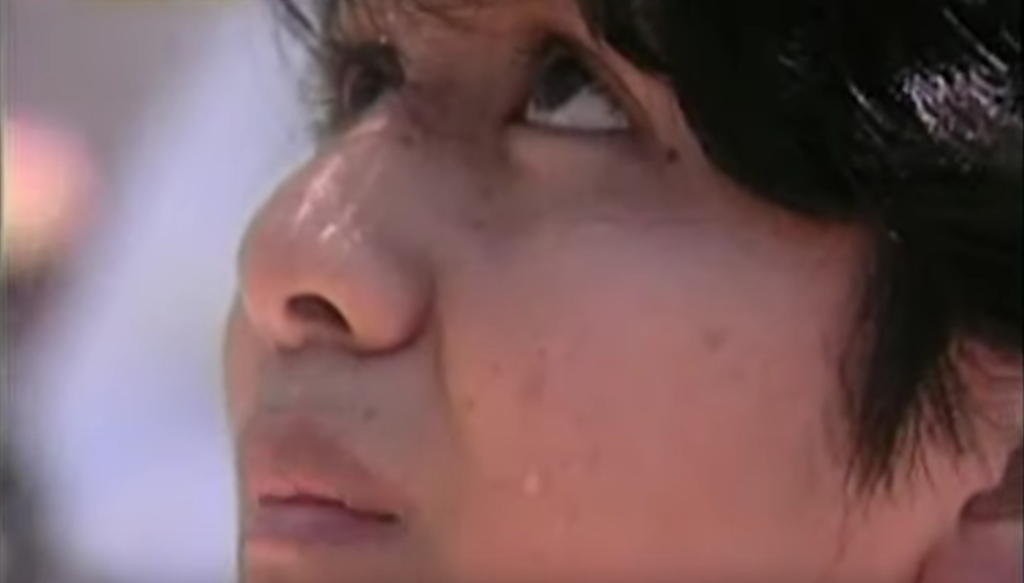“The Virgin Mary spoke to me. She has come down from heaven and has a message for everyone.” These were the words of a young boy named Judiel Nieva —now a transwoman–while looking up at a guava tree in March 1989. Nieva claimed to witness an apparition of the Virgin Mary right at her home in La Union, which was later billed as the “Miracle of Agoo”. Nieva was believed to have personal visions of the Virgin Mary since 1987 when she was only 10 but it was only two years later that she reported the first public apparition, alleging that she saw a bright light, heard sounds of trumpets, and angelic voices singing Alleluia and Salve Regina.

She said she also saw the Holy Family appearing in a cloud, with Mama Mary holding the baby Jesus in her lap. According to Nieva’s clear vision, the Blessed Virgin Mary was a lady wearing a white tunic, with six stars on the forehead, standing on a cloud embellished with seven roses, and weeping. Soon, the statue was called “Our Lady of Agoo, Immaculate Queen of Heaven and Earth”.
Mysteries and Marian apparitions
Marian apparitions are supernatural appearance of the Blessed Virgin Mary over a period of time. In order for it to be categorized as a Marian apparition, the visionary (or “seer”) or the person who claim to have the vision must prove that they see her as a three-dimensional person. Otherwise, it would only be classified as an interior locution or just a supernatural communication through the sense of hearing or via imagination. Similarly, ordinary natural phenomena such as dreams, or miracles linked with a Marian artwork (including weeping or bleeding statues) does not fall into the category of an apparition. Simply put, apparitions have mediations of a divine power.
The more famous Marian apparitions recognized by the Vatican include those in Guadalupe Mexico (The Virgin of Guadalupe, 1531), Rue du Bac, France (The Miraculous Medal as seen by Catherine Laboure, 1830), Fatima, Portugal (Our Lady of Fatima, seen by Lucia dos Santos, and Francisco and Jacinta Marto in 1917), and Medjugorje, Bosnia-Hercegovina (Our Lady of Medjugorje in 1981).
The Holy See has always been cautious in deciding for or against claimed miraculous events or apparitions. In the Philippines, there is not a single Marian apparition approved by the Vatican, not even the one in Lipa known as the Mediatrix of all Graces, which showered rose petals with the Virgin Mary’s faces on it in Lipa, Batangas in 1948.
In the case of the Agoo phenomenon which spanned three years, and after gathering a multitude of devotees (and some just snooping individuals) who travel daily from all over the Philippines to get a glimpse of the apparition, the dancing sun, and even of the visionary herself, the Roman Catholic Church declared that as a “non-supernatural” and ended the apparition claims in 1993.
Nieva’s journey to Apparition Hill
Visionary Nieva claimed to have personal encounters inside her home, since she was 10 and was reported to already possess extraordinary powers (like being able to detect a non-believer from a distance). Her name, by the way means “Bearer of God’s mercy” and she took that to heart, writing down all messages that she received from her visions. The 7th child of 8 siblings, Nieva was born to a poor family, and her parents owned two stalls in a local market selling anything just to make ends meet. But her visions became so frequent eventually, and one day, The Virgin Mary instructed her to go with some friends to a small hill in Agoo, where the first public apparition happened.
Apart from the popular ones she claimed to see, Nieva also mentioned that she saw Angels Michael, Gabriel, Uriel, Rafael, Setiel, Barachiel, and her namesake Judiel. The Blessed Mother also promised to speak to her every weekend and during Her feast days. Reports say that over 50 public apparitions were noted from 1989 until 1993. It was reported that in May 1993, an estimated one million people gathered at the Apparition Hill to witness Nieva’s claim. There were devotees, yes, but there were government officials, reporters and journalists, and the local bishop of La Union (acting as the Holy See’s representative) gathered to witness the apparition.
Months later, news featured that the family Nieva’s Virgin Mary statue began weeping profusely of blood tears, as witnessed by devotees for one afternoon mass. Some claimed they visited the site, seen the visionary and were healed. Others attested to the dancing, spinning sun. Nieva would be heard praying, singing, or reading the alleged messages of the Virgin Mary, encouraging people to pray the Rosary, penance, and spiritual transformation. Nieva also revealed the seven Secrets to Heaven (attending daily mass, going to confession regularly, and wearing the brown scapular, among others). One of Nieva’s most talked about unexplained personal phenomenon was that consecrated host which turned into fresh flesh and, which was alleged to be of Jesus Christ.
La Union Bishop Salvador Lazo created a seven-man Theological Commission to probe, gather data, and testimonies to be submitted to the Vatican and despite manifestations, denounced all claims, attributing all events were for show or for commercial gain.
To date, Nieva is a transwoman who is now known as Angel de la Vega, a businesswoman and an actress who starred in the film, “Siklo” (playing the role of a woman). She has undergone breast implant surgery as part of her transformation. When she guested in The Buzz in 2003, host Kris Aquino asked Nieva if she continued to see the Blessed Virgin Mary, Nieva did not reply. It was in 2003 when people would ask her about her gender and sex change, Nieva always answered: “Ito ang kagustuhan ng Mahal na Birhen” (This is what Mama Mary has desired things to be).

Walang Himala!
Filipinos always have this special love and fondness for the Blessed Virgin Mary. Devotees pray the Rosary and Angelus daily, do Novenas, and even revere Mary with a procession during her important Feast days and all these are great and tangible ways to venerate the Mother of God. Is there any harm in that? No. What is questionable is the extreme fanaticism of some Filipinos who are actually stuck on and eager to just witness a supernatural phenomenon, nothing else. The rush of most people to immediately embrace a doubtful and unsubstantiated “miracle” is alarming because these same people show little or no interest in the Gospel.
It’s so deeply rooted in our culture. We are eager to run to a hill to see a weeping statue but neglect our need for real Eucharistic adoration. We claim to have dreamt of divine messages but don’t have the time to pick up the Holy Bible and see the real heaven-sent messages there. We wipe our handkerchiefs on the statue’s hands and feet for healing, but we don’t even have time to go to Confession to cleanse and cure our souls.
Nieva’s journey reminds me of the story of Elsa (in Ishmael Bernal’s Himala), a teenager from a barrio who claimed of supposed vision of the Virgin Mary in a northern part of the Philippines. The apparitions eventually led her to faith healing and brought pilgrims and tourists to visit their barrio and gave the small place an opportunity for commerce. That made her an overnight sensation and changed her life, and of the barrio folk’s, forever. But just like in Nieva’s era, Elsa also ignited fanaticism and people—all in the name of blind faith—believed she could heal even the most helpless, hopeless of cases.
Perhaps Elsa’s unforgettable lines still ring true today: “Walang himala! Ang himala ay nasa puso ng tao! Nasa puso nating lahat! Tayo ang gumagawa ng himala! Tayo ang gumagawa ng mga sumpa at ng mga Diyos!”(There is no miracle. Miracles are inside the hearts of people. Inside us! We make our own miracles. We make our own curse and gods!)
This is us. Elsa and Nieva are you and me. We are also the blind zealots. Sometimes our concept of religion and spirituality is still based not on faith but on beliefs that bend the truth. We are still waiting for an omnipotent human savior that will save us from all these problems and heal our land from greed, corruption, selfish politics, and heinous crimes. We are still trapped inside our own illusions.
But then again, in our helplessness, we realize that the vision is crystal clear: we are individual miracles. We are our own channels of grace.
Other POP! stories you might like:
‘Pito-Pito’ movies was the remedy of an ailing 90s Philippine cinema
Jingle Magazine: Striking a nostalgic chord to our long-lost childhood




